Collaboration and Communication
These webpages present some of the best thinking on collaboration and strategic partnerships, with the aim of helping your leadership team define the functions that need be accomplished to execute a successful ACP program, including suggestions for important processes and tasks and who will take the lead on each one. The driving concern as you make these decisions is to identify the services and environment needed to ensure participant success and then make it a reality.
Read about the importance of collaboration and how to get it started. Learn more about other facets of collaboration and program implementation.
Collaboration
Cross-agency partnerships are crucial to successful program development and implementation. If you are starting from scratch, it’s important to know that forming a successful partnership takes time.
 There is no one administrator responsible for the success of ACP program partnerships. Leaders from all of the partnering organizations must take an active role and work collaboratively to ensure success of the learners and the program.
There is no one administrator responsible for the success of ACP program partnerships. Leaders from all of the partnering organizations must take an active role and work collaboratively to ensure success of the learners and the program.
You might be tempted to just jump in and do the work yourself. This approach may seem more efficient in the short term but is likely unsustainable. Why is it important to do the work to develop meaningful partnerships? Watch this Department of Labor (DOL) WEadership: The Future of Workforce Leadership video and learn why.
WEadership Superpowers
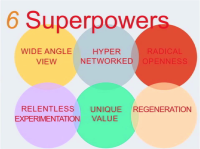 You don’t need to be a superhero, acting alone. These WEadership superpowers foster collaborative leadership. If your partnering leaders all take this approach, imagine how much can be done!
You don’t need to be a superhero, acting alone. These WEadership superpowers foster collaborative leadership. If your partnering leaders all take this approach, imagine how much can be done!
For more information on how to be an effective collaborative leader, watch this 12-minute YouTube video on developing the six superpowers of “WEadership,” as defined by social policy researcher Kristin Wolff (pictured above).
One Last Resource
Watch a webinar recorded by the DOL/Employment and Training Administration called “Building Cross-Agency Partnerships." (Note: you may need to logon or create a Workforce3One.org account to see it.)
Steps and Processes
Now you need to identify the functions necessary for a successful project and assign them to the appropriate agency and leader.
The DOL's ACP Toolkit provides great information about the functions required for successful implementation. Read this Toolkit section, "Build Cross Agency Partnerships and Clarify Roles."
The most effective transitions programs utilize the strengths of each partnering organization. The Literacy Information and Communication System (LINCS) has a course, "Building Strategic Partnerships," for building collaboration amongst transitions partners. The course is intended for adult education program administrators interested in building new, and strengthening existing, partnerships essential for successful development and implementation of ACP programs and systems.
The self-paced course features three modules:
- Understanding Strategic Partnerships
- Engaging Strategic Partnerships
- Sustaining Strategic Partnerships
Register at the LINCS website for a free LINCS site account to access the course.
Communication Tips
 Once you’ve built the processes and started implementation, the project is still going to need regular attention. How will you get ongoing information on what’s going right and what’s going wrong?
Once you’ve built the processes and started implementation, the project is still going to need regular attention. How will you get ongoing information on what’s going right and what’s going wrong?
You need to establish routines for monitoring your implementation. You need to communicate so that you can be flexible and make adjustments mid-stream if something is not working.
Be Present with Key Staff
- Meetings. It is crucial to bring leadership together for operations meetings to ensure that work is being done effectively. Such meetings are an opportunity to focus on participant experience, looking deeper to ensure that expectations are being met.
- Plan ongoing communication. How often will administrative leaders communicate with key staff and how?
- Plan your strategy for regularly checking in with frontline staff to learn about missteps, challenges, barriers, and successes happening in the program.
Get Information from Staff
The fact that your partnership is built from multiple agencies means that you can leverage everyone’s strengths to best support program participants. To make this happen, it is crucial for everyone to have access to information about processes, deadlines, and the experience of the participants.
Your regular meetings might be adequate for keeping tabs on all the moving parts. You might, however, consider creating a central source of information for everyone. Shared web tools are perfect for such projects. Here are a few that you might consider using:
Dropbox - Web-based file sharing system that lets you share files with others. You can use it online or tie it to your folders and files on your hard drive.
Google Drive - This is a web tool you can use to share files. It is different from Dropbox because you cannot sync your Google Drive folders and files to the hard drive on your computer. To access the documents, you need to be online.
Google Sites - This is an easy way to create a project website that you can use to post a project description or summary, a calendar, contact information, required documents, and any other information that your partnership needs to collaborate efficiently.
Ning - Unlike the other suggestions, this one is not free. However, you can make a project website with a bit of patience, especially if you use a project template.
Defining Roles
Sector Partnerships
ACP programming changes service delivery strategies for each participating agency. Collaboration amongst all partners makes this change possible.
Listen to Judy Mortrude from the Minnesota Department of Employment and Economic Development describe this shift using materials published by the National Governor's Association:
Also, read a PDF of the entire presentation.
Identifying Leadership
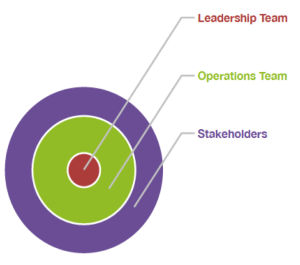 As your partnership and group of stakeholders grows, consider organizing a standing team of leaders across systems who can help guide this work from one program to a whole movement!
As your partnership and group of stakeholders grows, consider organizing a standing team of leaders across systems who can help guide this work from one program to a whole movement!
Articulate a development plan for, and identify membership of, a council to address logistical needs, bridge administrative gaps, and support the use of data to inform program improvement.
Once you form this team of players from each agency, you can begin to identify functions of your partnership and program tasks. See below for strategies to help you distribute this work.
Identifying Functions
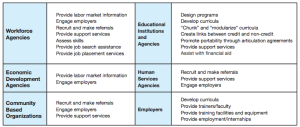 Now you need to identify the functions necessary for a successful project and assign them to the appropriate agency and leader.
Now you need to identify the functions necessary for a successful project and assign them to the appropriate agency and leader.
The Department of Labor “Toolkit” provides great information about the functions required for successful implementation.
See one way to assign these functions.
Local Examples
The Ramsey County Healthcare Initiative has defined its own list of functions, based on what has been learned over four years of implementation.
See how they present this information to stakeholders. Note that each agency responsible for the function or task described on the side is highlighted. Not all agencies are responsible for all of the tasks.
Use this presentation to think about how you will define functions and tasks and who will contribute time and resources to make each one happen.
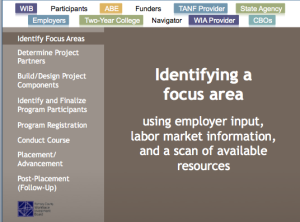
Evaluation
There are two levels of evaluation to be considered when measuring the success of your program implementation:
- Monitoring to ensure that frontline staff have the direction and support they need to adequately support program participants.
- Program-wide evaluation to ensure that all functions and tasks required for successful implementation are carried out.
Frontline Staff Evaluation
Begin putting into place evaluation processes to ensure the quality of instruction and advising that supports your participants. It is likely that you can base evaluation of integrated instructors and navigators on current materials and processes; however, you will need to make adjustments to account for the functions and responsibilities unique to ACP programming.
Instructors
There are a number of key times to check-in with instructors to see how their collaboration is going. Consider evaluating the following characteristics or tasks:
- Integrated Adult Basic Education (ABE) and Career and Technical Education (CTE) Outcomes - Did your teachers create an Integrated Outcomes document, listing CTE course outcomes and relevant ABE benchmarks? Such a document can serve as a useful guide to future teachers of the course. If outcomes were written, are they comprehensive, realistic, and developed in a useful format?
- Collaborative Planning – Consider making collaborative lesson planning time part of your teacher evaluation observation. Make sure there is shared planning time. Check out the process and the resulting lesson plans.
- Shared Response to Assessments – Make sure instructors can articulate their process for coordinating assessments and evaluation of participants. Make sure each knows what the other is doing and how the assessments support each other.
- Use of a Variety of Paired Instruction Models – Facility with all of the models should be a goal because it will help instructors best leverage each others' strengths in response to what happens in the classroom.
Navigators
Ensure that your navigators are supporting participants using the following tools and strategies:
- A comprehensive list of support service opportunities and organized contacts.
- A thoughtful participant intake process.
- Process for providing proactive support for learners. Do navigators have regular workshops with participants on common issues that cause barriers to success? Such proactive support builds trust and buoys persistence. Check to see if the navigator has a plan for proactive support.
- Employment plan for participants.
- Monitoring support log for tracking calls and meetings and their outcomes.
Program Evaluation
Your evaluation should include both mid-course continuous improvement activities and end-of-program outcomes-based evaluation.
Continuous Improvement
In part, successful continuous improvement requires:
- Using stated program outcomes as benchmarks to define project success.
- Making progress toward the integration of your ACP program into the operations of partner institutions.
Here is one useful example of a formative program evaluation developed in Michigan: Career Pathways in Michigan Toolkit.
Outcomes-based Evaluation
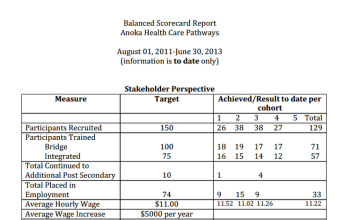
Evaluations based on data are the best way to gauge your success. A promising practice called “The Balanced Scorecard” can help you organize your evaluation.
The Balanced Scorecard is a strategic management tool used to align institutional activities to the vision and strategy of the organization or project.
"It was originated by Drs. Robert Kaplan and David Norton as a performance measurement framework adding strategic non-financial performance measurements to traditional financial targets to give managers a more “balanced” view of organizational performance. Clarifies vision and strategy into action and it provides a feedback tool that can be discussed and improved upon.” - Nancy James, Division Director, HIRED.
The first Balanced Scorecard to support Minnesota FastTRAC program evaluation was used by the Metro West Healthcare FastTRAC project in 2012. It was created by Nancy James of HIRED.
Monitoring Policy/Guide


 There is no one administrator responsible for the success of ACP program partnerships. Leaders from all of the partnering organizations must take an active role and work collaboratively to ensure success of the learners and the program.
There is no one administrator responsible for the success of ACP program partnerships. Leaders from all of the partnering organizations must take an active role and work collaboratively to ensure success of the learners and the program. You don’t need to be a superhero, acting alone. These WEadership superpowers foster collaborative leadership. If your partnering leaders all take this approach, imagine how much can be done!
You don’t need to be a superhero, acting alone. These WEadership superpowers foster collaborative leadership. If your partnering leaders all take this approach, imagine how much can be done! Once you’ve built the processes and started implementation, the project is still going to need regular attention. How will you get ongoing information on what’s going right and what’s going wrong?
Once you’ve built the processes and started implementation, the project is still going to need regular attention. How will you get ongoing information on what’s going right and what’s going wrong?  As your partnership and group of stakeholders grows, consider organizing a standing team of leaders across systems who can help guide this work from one program to a whole movement!
As your partnership and group of stakeholders grows, consider organizing a standing team of leaders across systems who can help guide this work from one program to a whole movement! Now you need to identify the functions necessary for a successful project and assign them to the appropriate agency and leader.
Now you need to identify the functions necessary for a successful project and assign them to the appropriate agency and leader.
